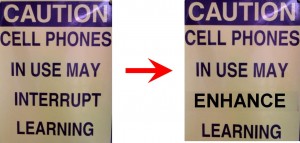Text messaging has become one the fastest and most popular forms of communication. Just a few years ago, cell phones were seen as the newest teenage addiction. Today, however, they can be an important classroom tool, although some schools regard them as disruptive, distracting, and have implemented policies that prohibit using them on school grounds. Most parents are okay with cell phone use, the students are more than okay with cell phone use, yet schools have adopted zero tolerance policies. The reality is that students still use cell phones in school even if they are banned. According to the PEW Internet and American Life Research Project, 58% of teens from schools that forbid cellphones, use them during class anyway.
Some teachers worry that cellphones will increase cheating, lead to sexting, decrease use of proper grammar, and be a distraction to learning. While I can’t disprove these concerns, I can state that educating students about responsible and purposeful cellphone use is needed. What agitates me most about schools banning cellphones outright is that they are missing out on an opportunity for growth, collaboration, information, and FREE technology.

Increasing costs and disappearing school funding has made updating technology often impossible and even basic school supplies dwindle. Challenging times require teachers to get creative. Schools across the country need to realize that the technology of the future is already in students’ back pockets, falling out of their skinny jeans, or officially “in their lockers.” How long will it take schools to realize that banning cellphones is not the answer?
Why should cell phones be allowed in schools?
I polled my students to discover that 95% of my 8th graders owned a cell phone and 55% had smart phones. My students are not just making calls, texting, and updating Facebook. They are making social connections, collaborating, researching, and sharing information.

Schools across the country need to be more flexible with their cell phone policies. Cell phones can replace reference books, flip cameras, calculators, cameras, student planners, instant response devices, and so much more. They can save schools money and enhance instruction if done in an appropriate way.
With administrative and parental approval, I use a program called Cel.ly to send text messages to my students with reminders, announcements, polls, questions, etc. Students can text me and ask me a specific question such as “what is on the test tomorrow?” or ask “what did I miss in class?” when they were sick. Cell phones have the potential to bridge the gap between the home, school, and social media world.
Students can text me and ask me a specific question such as “what is on the test tomorrow?” or ask “what did I miss in class?” when they were sick. Cell phones have the potential to bridge the gap between the home, school, and social media world.
How can cell phones increase parent communication?
Frequent communication with parents is a necessity, but newsletters, classroom emails, and letters home to parents are becoming outdated. Last fall at South Western High School in Hanover, Pennsylvania, I encouraged parents to join my text messaging classroom group. I was surprised with the results. Of my 55 US history students, 35 of their parents participated. Parents commented that they appreciated the text message reminders about homework & tests, updates about their child’s progress, and even the in class texting activities. Parents are now more informed about how their kids are doing and are better able to help their children with their schooling, which is key to student success.
One activity in which I involved parents and cell phones I like to call “text a friend.” My students’ assignment was to text a family member or friend asking the question “Did you vote in the last election? Why or why not?” Through the responses they received they learned firsthand far more than just having the textbook or teacher’s perspective. Cellphones truly brings the world into your classroom.
For More Information: Here is a previous blog post about the ways cell phones can enhance instruction in the classroom. Here is a post about 10 educational apps that can be used in the classroom.
This post was crosspsted at Teach.com
